Last Updated on November 7, 2024 by teamobn
Open-plan living has become increasingly popular in modern home designs. By removing walls and creating a continuous flow between spaces like the kitchen, living room, and dining area, open-plan layouts maximize space, improve natural light, and encourage social interaction. However, designing a functional open-plan living space requires careful planning to ensure that the areas serve their purpose while maintaining a cohesive look.
Here are some practical tips for making the most of your open-plan living space.
Contents
Define Zones Without Using Walls
One of the key challenges of open-plan living is creating distinct zones without the use of traditional walls. To achieve this, you can use various design elements that visually divide the space while maintaining an open feel. For example:
- Furniture Placement: The way you position your furniture can help define different areas within an open space. For instance, a sofa can act as a boundary between the living area and the dining space.
- Rugs: Use rugs to differentiate zones such as the living room, kitchen, or dining area. A large rug under the dining table or coffee table anchors the furniture, creating a clear visual separation between spaces.
- Lighting: Lighting fixtures, such as pendant lights over a kitchen island or a chandelier in the dining area, can highlight the distinct functions of each space. Layered lighting, with ambient, task, and accent lights, also enhances functionality and mood.
Maintain a Cohesive Color Palette
A cohesive color palette is essential in open-plan living areas to create a sense of flow and unity. If each area of your space features vastly different colors or styles, the open layout can feel chaotic. Instead, opt for a consistent color scheme that flows throughout the space, but don’t be afraid to introduce subtle variations.
- Neutral Tones: Neutral shades such as whites, beiges, and greys work well in open-plan spaces as they provide a blank canvas and allow the different areas to blend seamlessly. Use bold colors sparingly as accents in decor, cushions, or artwork to add personality without overwhelming the space.
- Accent Colors: If you want to introduce color without disrupting cohesion, pick one or two accent colors and distribute them evenly across the entire space. For instance, if your kitchen features dark blue cabinetry, consider adding blue throw pillows or wall art in the living room.
Think About Traffic Flow
Traffic flow is an important consideration in open-plan living. The layout should allow easy movement between different zones without causing bottlenecks or awkward spaces. To optimize traffic flow:
- Create Clear Pathways: Ensure there’s enough space between furniture pieces and that movement between zones is smooth. Leave ample room between the dining table and seating areas, and consider how people will naturally move between the kitchen, living, and dining spaces.
- Avoid Clutter: Open-plan spaces are prone to clutter because they encompass multiple functions in one area. Keep surfaces clear, use built-in storage solutions, and ensure everything has its place to maintain an open, airy feel.

Use Multi-Functional Furniture
Because open-plan living areas often need to serve multiple purposes, it’s essential to choose furniture that enhances functionality. Multi-functional furniture can help maximize space and create a more flexible living environment. Consider these options:
- Extendable Tables: An extendable dining table allows you to adjust the size depending on your needs. When you have guests over, you can expand the table, and when you’re dining with fewer people, the smaller size helps keep the space open.
- Modular Sofas: A modular sofa is perfect for an open-plan living room because it can be reconfigured to suit different seating arrangements. Whether you need more space for entertaining or a cozy setup for family movie night, modular pieces offer flexibility.
- Storage-Integrated Furniture: Look for furniture with hidden storage to reduce clutter. For example, coffee tables with storage compartments or ottomans with hidden compartments are excellent for stashing items without taking up extra space.
Incorporate Vertical Design Elements
In open-plan spaces, it’s easy to focus only on the horizontal layout. However, vertical elements can be just as important for creating a balanced and visually interesting environment. Incorporating height into your design can add depth and dimension to the space. Here’s how you can do it:
- Tall Shelving Units: Use tall bookshelves or open shelving to break up large wall areas and provide additional storage without adding bulky furniture.
- Hanging Plants: Hanging plants or vertical gardens can introduce greenery and act as natural room dividers while adding visual interest.
- Statement Art or Lighting: Draw the eye upward by adding statement artwork, tall sculptures, or bold lighting fixtures that highlight the height of your room.
Plan for Flexibility and Future Needs
When designing an open-plan layout, it’s important to consider how your needs might change over time. For example, if you’re buying one of the many house and land packages in Sydney, you may need a flexible design that accommodates future changes in your family or lifestyle.
- Flexible Layout: Opt for furniture and design solutions that can be easily reconfigured as your needs evolve. Modular furniture, open shelving, and movable partitions can help create a space that adapts as your family grows or your lifestyle changes.
- Long-Term Functionality: Think about how each zone in your open-plan space will be used in the future. Will your kitchen island double as a homework station for kids? Could your living area be transformed into a home office?
Use Natural Light to Your Advantage
One of the most significant benefits of open-plan living is the abundance of natural light. Make the most of it by designing your layout to allow light to flow throughout the space.
- Large Windows: Large windows and glass doors help flood the space with light and make the area feel larger and more connected to the outdoors.
- Reflective Surfaces: Use mirrors and glossy surfaces, such as glass or polished tiles, to reflect natural light and brighten up darker areas of the space.
- Window Treatments: Opt for sheer curtains or blinds that allow light to filter in while providing privacy when needed.
Wrapping it up…
Creating a functional and stylish open-plan living area requires a thoughtful approach to layout, furniture selection, and design elements. By defining zones, maintaining cohesion, and planning for the future, you can make the most of this flexible design style. Open-plan living not only enhances the flow of your home but also encourages a more sociable and connected way of living.








